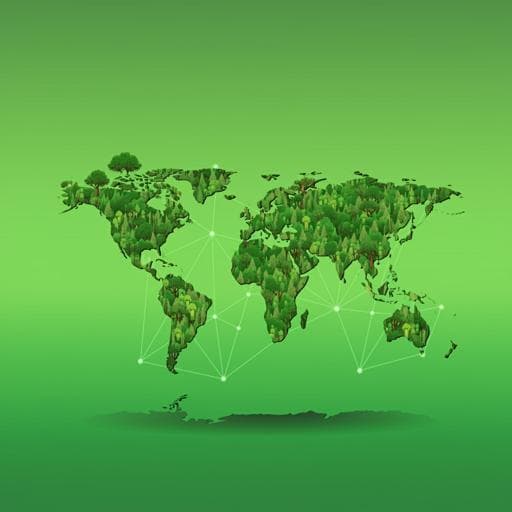
Environmental Studies and Forestry
Global inequities in population exposure to urban greenspaces increased amidst tree and nontree vegetation cover expansion
S. Leng, R. Sun, et al.
This study reveals that while urban tree cover has surged in cities globally, a troubling decline in human exposure to urban greenery has emerged in the Global South, intensifying regional disparities. Conducted by Song Leng, Ranhao Sun, Xiaojun Yang, and Liding Chen, the research underscores the urgent need for equitable greenspace strategies.
~3 min • Beginner • English
Introduction
Urban areas cover ~3% of Earth’s land surface yet host more than half of the global population. Achieving inclusive, safe, resilient, and sustainable cities (SDG 11) is challenged by rapid urban expansion that intensifies heat stress, habitat loss, air pollution, and water shortages. Urban vegetation is crucial for mitigating climate impacts, improving environmental quality, supporting biodiversity, and promoting human well-being, and many cities have seen greening trends in recent decades. However, prior evidence shows substantial inequality in greenspace exposure between the Global South and Global North, with nearly double the inequality in the Global South. It remains unclear whether widespread urban greening mitigates this inequality. Moreover, urban greenspace comprises trees and nontree vegetation (e.g., grasses), which have distinct ecological functions (trees deliver strong cooling, air-quality benefits, water retention, and carbon sequestration; grasses support biodiversity and social benefits). How these two vegetation components vary under ongoing urban greening, and how human exposure to each has changed, are open questions. This study undertakes a global analysis using satellite-derived vegetation, climate, and socioeconomic datasets to examine the spatiotemporal variability and drivers of urban tree and nontree vegetation and to assess changes in human exposure and inequality from 2000 to 2020.
Literature Review
Previous studies have documented widespread urban greening driven by urbanization using satellite-derived greenness indices, but these metrics do not separate contributions from different vegetation types. Work on greenspace exposure has shown stark inequalities, with Global South cities exhibiting nearly double the inequality compared to Global North cities when total greenspace is considered. Trees in cities can reduce summer maximum surface temperatures by up to 5.7°C, improve air quality relative to treeless areas, and outperform nontree vegetation in water retention and carbon sequestration. Grasses and other nontree vegetation contribute habitat and social benefits. Gaps remain regarding dynamics of exposure to tree versus nontree vegetation and how recent greening affects exposure inequality, motivating this study’s differentiation of vegetation types and assessment of exposure trends at fine spatial resolution.
Methodology
The study integrated multiple open-access datasets and statistical models. Vegetation coverage and greenness: (1) MODIS Vegetation Continuous Fields (MOD44B v6, 250 m) provided annual percent tree cover (TC), percent nontree vegetation (NTV), and non-vegetated area from 2000–2020. Quality masking retained pixels with at least 7 of 8 clear observations. (2) Landsat Global Forest Cover Continuous Fields (GFCC, 30 m) offered global tree canopy cover for 2000, 2005, 2010, and 2015. (3) MODIS MOD13Q1 Enhanced Vegetation Index (EVI) was used to compute annual maximum greenness (EVImax) per pixel, with stringent QA masking to reduce noise. City-scale means of tree cover, nontree cover, and EVImax were computed, and linear/nonlinear regressions assessed relationships. Urban-related datasets: Urban extent was derived from a simplified algorithm combining a global urban land database with LandScan population data; cities larger than 100 km² were selected, yielding 3567 clusters. Among these, 1464 cities had a significant trend in tree cover and 957 in nontree vegetation (Mann-Kendall p < 0.05). GAUL administrative layers supported multi-scale exposure analysis. Urban Development Index (UDI) was calculated as the ratio of built area to total urban extent using the 30 m impervious surface dataset (1985–2018). Climate datasets: TerraClimate provided monthly variables including actual evapotranspiration, climatic water deficit, soil moisture, precipitation, downward shortwave radiation, and vapor pressure deficit; ERA5 supplied monthly reanalysis (air temperature statistics, precipitation, pressures, winds). Socioeconomic datasets: Population distributions were from GPWv4 (2000–2020, ~1 km). Gridded global GDP and HDI (2015, 30 arc-seconds) characterized socioeconomic status. Statistical analyses: Trends in tree and nontree cover were detected with Mann-Kendall tests and Theil-Sen slopes (p < 0.05). Relative importance analysis and partial correlation quantified contributions of climate, geographic, and socioeconomic variables. Generalized additive models (GAMs) modeled urban greenspace versus drivers, combining four climatic drivers (climatic water deficit, shortwave radiation, soil moisture, mean maximum air temperature) and three socioeconomic drivers (HDI, population density, UDI): g(E(Y)) = f1(def) + f2(srad) + f3(sm) + f4(Tmax) + f5(HDI) + f6(POP) + f7(UDI). Cross-validation evaluated robustness. Population-weighted exposure model: Human exposure to trees (HET) and to nontree vegetation was computed as HET = Σ(Pi × TCdi)/Σ(Pi), where Pi is population in pixel i and TCdi is fractional vegetation cover incorporating adjacent greenspace within buffer d. Inequality metric: Gini coefficients quantified inequality in exposure at city to continental scales for 2000–2020 based on Lorenz curves.
Key Findings
- Urban vegetation trends: About 90% of cities (1320/1464) had significant increases in tree cover; 48.8% (467/957) had increases in nontree vegetation (p < 0.05). Urban tree cover correlated more strongly with greenness (EVI) than nontree vegetation and nearly matched the correlation of total greenspace (UGS) with EVI.
- Spatial patterns: Strongest tree cover increases occurred in high-latitude Northern Hemisphere regions (Eastern Russia, Northern Europe). Declines in tree cover were common near the equator (Central America, Western Africa, South-Eastern Asia), along the northern Black Sea coast, and in Western Asia.
- Drivers (GAM results): The combined climate + socioeconomic GAM explained ~69.6% of deviance (climate-only 65.2%, socioeconomic-only 40.1%). Thermal-hydrologic stressors (climatic water deficit, vapor pressure deficit) had stronger negative associations with tree cover than precipitation/soil moisture alone. Shortwave radiation was significantly related to tree cover. Tree cover increased with annual mean maximum temperature below ~15°C and declined above that threshold. Socioeconomic drivers: HDI showed a positive association beyond ~0.7; population density and UDI were negatively correlated with tree cover (R ~ -0.41 to 0.3 across factors).
- Exposure outcomes: Mean human exposure to urban trees (HET) declined in the Global South from 5.22% (2000) to 4.13% (2020). In the Global North, HET remained relatively stable (15.3–15.4%). A majority of cities saw HET declines: 57.8% in the Global North and 88% in the Global South, with notable reductions in Africa.
- Inequality: Gini coefficients for tree exposure increased: Global North 0.26 (2000) to 0.29 (2020); Global South 0.30 to 0.36. Exposure to nontree vegetation was relatively stable in both regions; the Gini index for nontree exposure decreased slightly.
- Regional highlights: Most sub-continental regions experienced HET declines except Eastern Europe and Eastern Asia. Australia & New Zealand’s HET inequality decreased (Gini 0.16 to 0.14). Asia and Africa saw notable increases in inequality, reaching Gini ~0.6 in Western Asia. China, India, and the United States showed declining HET with increasing inequality; Russia showed rising HET with a slight Gini increase, influenced by depopulation in Eastern Russia.
Discussion
The study addresses gaps in understanding how different greenspace components contribute to urban greening and human exposure. It shows that urban greening over 2000–2020 was driven primarily by tree cover gains, especially in high-latitude cities, where warming and depopulation likely facilitated tree expansion. In warmer regions, increasing temperatures and urban heat islands exacerbate water deficits and hinder urban tree growth, aligning with observed declines near the equator. Socioeconomic development beyond an HDI threshold (~0.7) supports greater tree cover, while higher population density and urban development intensity suppress it. Despite increased tree cover, human exposure to urban trees declined across much of the Global South, and inequality increased in both the Global North and South. Differentiating tree versus nontree vegetation clarifies that trees, which deliver stronger cooling, air quality, and carbon benefits, are not equitably experienced by populations. Findings highlight the need for targeted, evidence-based urban greening strategies that prioritize equitable distribution of tree and nontree vegetation, preventing concentration of benefits in privileged neighborhoods and addressing disparities in rapidly urbanizing regions. The data-integration approach at finer spatial granularity advances prior work by isolating contributions of vegetation types, enabling more nuanced policy and planning interventions.
Conclusion
Urban greening in the first two decades of the 21st century was predominantly driven by increases in urban tree cover, yet population-weighted exposure to trees declined in many cities—especially in the Global South—while inequality in exposure increased globally. Distinguishing tree from nontree vegetation provides critical insights into ecological functions and equity outcomes. Policymakers and planners should implement evidence-based strategies to ensure equitable access to both vegetation types, incorporating urban planning policies, land-use regulation, community initiatives, and environmental awareness. Meeting SDG targets for universal greenspace access by 2030 remains challenging. Future work should improve urban vegetation mapping accuracy (e.g., via higher-resolution datasets and field calibration), incorporate dynamic urban boundaries, and use more direct anthropogenic indicators (such as investments in green infrastructure) to better explain and manage greenspace dynamics and exposure equity.
Limitations
- Modeling uncertainty: GAMs explained ~70% of global urban tree cover variability and ~28.8% for nontree vegetation, indicating unexplained variance.
- Socioeconomic proxies: Limited, unified global urban inventories required use of GDP, HDI, and UDI as surrogates for anthropogenic drivers; lack of direct data on green infrastructure investments constrains interpretability.
- Urban boundary assumptions: Analyses used constant urban boundaries for 3567 cities despite rapid urban expansion, potentially biasing estimates; dynamic annual urban extent could reduce uncertainties.
- Remote sensing limitations: Urban vegetation cover accuracy is lower due to high heterogeneity and limited high-quality inputs; discrepancies exist between datasets (e.g., MODIS VCF vs. WorldCover for nontree vegetation). Field calibration and very high-resolution products (e.g., 1 m SinoLC-1) could improve estimates.
- Exposure estimation: Population-weighted exposure relies on gridded population data and buffer assumptions, which may introduce uncertainty in local exposure patterns.
Related Publications
Explore these studies to deepen your understanding of the subject.







